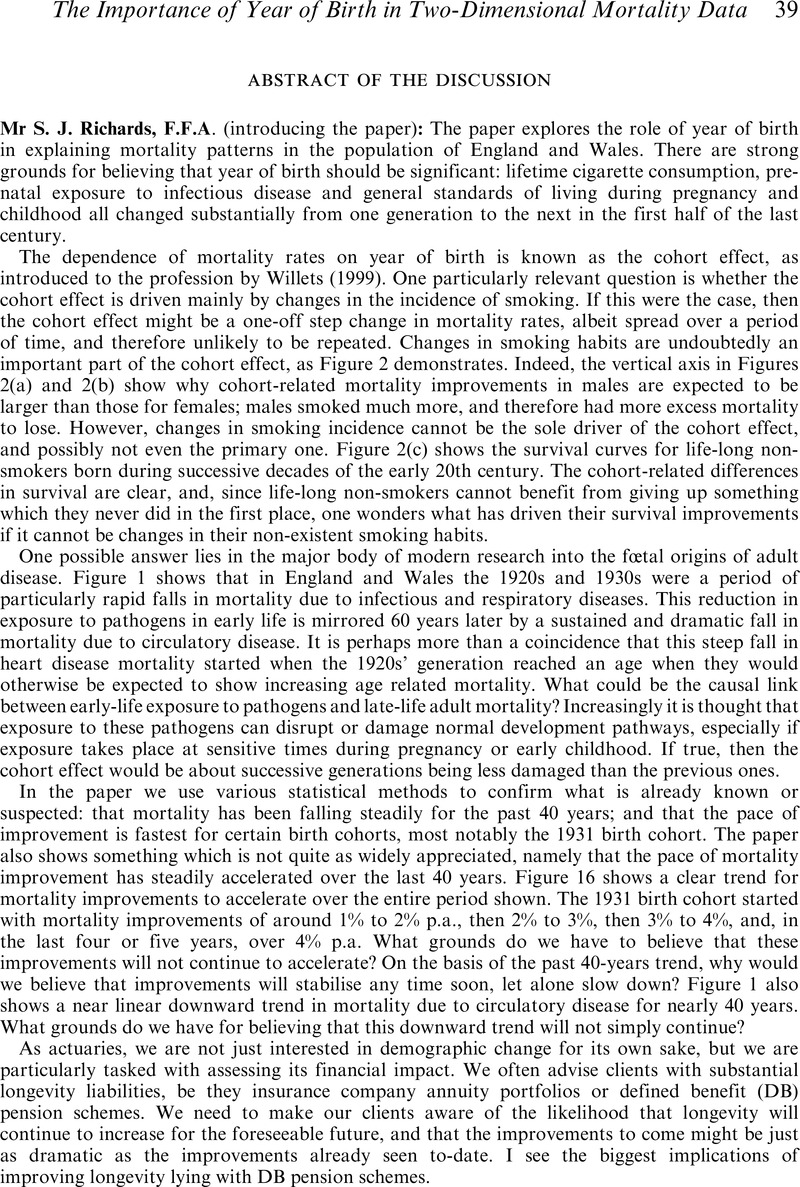No CrossRef data available.
Article contents
The Importance of Year of Birth in Two-Dimensional Mortality Data. Abstract of the Discussion
Published online by Cambridge University Press: 10 June 2011
Abstract
An abstract is not available for this content so a preview has been provided. Please use the Get access link above for information on how to access this content.

- Type
- Sessional meetings: papers and abstracts of discussions
- Information
- Copyright
- Copyright © Institute and Faculty of Actuaries 2006
References
The Economist (2005). 15 October.Google Scholar
Financial Times (2005). 10 October.Google Scholar
Lane, Clark & Peacock LLP (2005). Accounting for pensions: annual survey 2005. Richards Consulting calculations using data from pp33, 35.Google Scholar
Richards, S.J. (2005). Longevity risk. Presentation to the Faculty of Actuaries Students' Society. Available at www.richardsconsulting.co.uk/calendar.htmlGoogle Scholar
Derrick, V.P.A. (1927). Observations on (1) errors on age on the population statistics of England and Wales and (2) the changes in mortality indicated by the national records. Journal of the Institute of Actuaries, 58, 117–159.Google Scholar
Kermack, W.O., McKendrick, A.G. & McKinlay, P.L. (1934). Death rates in Great Britain and Sweden: some general regularities and their significance. Lancet, 226, 698–703. Reprinted (2001) in International Journal of Epidemiology, 30, 678-683.CrossRefGoogle Scholar
Kuh, D. & Davey Smith, G. (2004). The life course and adult chronic disease: an historical perspective with particular reference to coronary heart disease. In A life course approach to chronic disease epidemiology: tracing the origins of ill-health from early to adult life, Kuh, D. & Ben-Shlomo, Y. (eds.), 2nd edition. Oxford University Press, 15–40.Google Scholar
Kuh, D., Hardy, R., Langenberg, C., Richards, M. & Wadsworth, M.E.J. (2002). Mortality in adults aged 26-54 years related to socioeconomic conditions in childhood and adulthood: post war birth study cohort. British Medical Journal, 325, 1076–1080.Google Scholar
Sparen, P., Vagero, D., Shestov, D.B., Plavinskaja, S., Parfenova, N., Hoptiar, V., Paturot, D. & Galanti, M.R. (2004). Long term mortality after severe starvation during the siege of Leningrad: prospective cohort study. British Medical Journal, 328, 11–14.CrossRefGoogle ScholarPubMed
Alter, G. (1983). Plague and the Amsterdam annuitant: a new look at life annuities as a source for historical demography. Population Studies, 37, 23–41.Google Scholar
Redington, F.M. (1981). The flock and the sheep and other essays. Journal of the Institute of Actuaries, 108, 361–404.CrossRefGoogle Scholar
Renshaw, A.E. & Haberman, S. (2006). A cohort-based extension to the Lee-Carter model for mortality reduction factors. Insurance: Mathematics and Economics, 38, 556–570.Google Scholar




